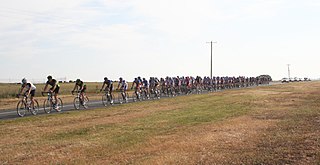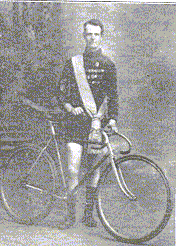Related Research Articles

The Melbourne to Warrnambool Classic cycling race is a one-day road bicycle race. The race started in 1895 and is Australia's oldest one day race and the world's second oldest one day race, after the Liège–Bastogne–Liège Classic. Historically until 1938 the race started in Warrnambool and finished 165 miles (266 km) later in Melbourne. In 1895 the race was run in the opposite direction, from Melbourne to Warrnambool and then again from 1939. The route started in the Melbourne central business district and followed the Princes Highway to Warrnambool on Victoria's western coast. This traditional route was the longest race on the Union Cycliste Internationale (UCI) calendar, the exact distance varying slightly over time.

William Walker (born 31 October 1985 in Subiaco, Western Australia) is a retired Australian professional road racing cyclist and Australian Champion who rode for the Dutch team Rabobank between 2005 and 2008 and Spanish team Fuji–Servetto in 2009. Walker was described as having a motor on par with Lance Armstrong, with a reported recorded VO2 max94. Walker was also heralded as Australia's next Cadel Evans.
Robert 'Barry' Waddell was an Australian cyclist of the 1960s. Waddell won a record 5 straight Herald Sun Tours from 1964 to 1968. Although best known as a road cyclist, Waddell was in fact an "all-rounder", having also won a number of national track titles. He won the Australian national road race title in 1964 and 1968. He won the general classification in the Herald Sun Tour five years in a row (1964-1968) when the Sun Tour was at its most gruelling, covering 1200 miles (1920 km) in nine days. Waddell took fastest-time honours in the Melbourne-to-Warrnambool road race no fewer than three times and won the Sir Hubert Opperman trophy twice, breaking Opperman's record from Adelaide to Melbourne. Subsequently, after his professional cycling career had finished, he also won the 1975 world veterans' title in Austria.

Richard William "Fatty" Lamb was an Australian racing cyclist who competed on both road and track, as was typical of Australian cyclists of the era such as Hubert Opperman. Throughout his career, Lamb was associated with Malvern Star Bicycles and Bruce Small.
Iddo "Snowy" Munro was an Australian racing cyclist. The highlights of his career were winning the Australasian long distance road championship in 1909 and competing in the 1914 Tour de France. Munro won the championship by winning the Blue Riband for the fastest time in the Warrnambool to Melbourne race. Munro set a record time of 7h 12' 51" which was not broken until 1931. Munro had a long association with the Warrnambool and his other efforts were 30th in 1907, 45th and fastest rider receiving over 10 minute start in 1908 and 60th in 1910.
Alby Barlow was an Australian racing cyclist from 1935 who rode for Oakleigh. In 1947 he was the Australian 100 miles road champion and holder of the 25, 50 and 100 miles Australian unpaced road records.
Keith Rowley (1919–1982) was an Australian racing cyclist.
Alby Saunders was an Australian racing cyclist.
Jamie Peter Drew is an Australian former racing cyclist. He won the Australian national road race title in 2000. He won the Melbourne to Warrnambool Classic in 1999 and 2002.
Frankie Thomas was an Australian racing cyclist who competed on both road and track, as was typical of Australian cyclists of the era such as Hubert Opperman.
Walter "Hefty" Stuart (1912–1938) was an Australian cyclist who competed on both road and track, as was typical of Australian cyclists of the era such as Hubert Opperman and Richard Lamb.
Tom Larcombe (1881-1967) was an Australian racing cyclist with notable success in long distance road races.

Ernest "Ernie" Bainbridge (1890–1984), also known as Ern Bainbridge, was an Australian racing cyclist, who is best known for competing in the 1928 Tour de France with fellow Australian Percy Osborn and Hubert Opperman and New Zealander Harry Watson.

Duncan "Don" Kirkham was an Australian racing cyclist. Kirkham was a regular competitor in Australian long distance cycling races. He won the Goulburn to Sydney Classic in 1910, riding off scratch and setting the fastest time. In 1911 he was 2nd and set the fastest time, riding the 131 miles (211 km) in a record time of 6h 19' 31". Kirkham's time was not beaten until 1925 by Richard "Fatty" Lamb. He had previously finished 5th in 1909. and finished outside the top 20 in 1912.
John Beasley was an Australian racing cyclist and rode in the 1952 and 1955 Tour de France.
Alan "Pete" Angus (1912–1988) was an Australian racing cyclist.

The Dunlop Grand Prix was, in 1927, the biggest cycling race in the British Empire and the richest race in the world. It was organised by the Dunlop Rubber Company which had a long history of organising bicycle races, including the Warrnambool to Melbourne, Colac to Melbourne and Goulburn to Sydney. As a result of the Dunlop Grand Prix, the Warrnambool was not held in 1927 however the Colac and Goulburn races were.

Ken Gordon Ferndale Ross (1900–1974) was an Australian road and track cyclist. His best results were achieved in the Goulburn to Sydney, where he set the fastest time on three occasions and in the Sydney Six-day race which he won three times.

Sam Welsford is an Australian professional racing cyclist, who currently rides for UCI WorldTeam Red Bull–Bora–Hansgrohe.
Nicholas White is an Australian professional racing cyclist, who currently rides for UCI Continental team Team BridgeLane.
References
- ↑ "Cycling Grand Prix To Phil Thomas (SA)". Sporting Globe. National Library of Australia. 12 October 1946. p. 4.
- 1 2 "Rowleys take cycle honors". The Sporting Globe . Melbourne, Vic.: National Library of Australia. 11 September 1948. p. 6.
- 1 2 "Retired but won rich cycling race". The Argus (Melbourne) . Melbourne, Vic.: National Library of Australia. 11 October 1948. p. 14.
- 1 2 "M. Rowley proves his class". The Argus (Melbourne) . Melbourne, Vic.: National Library of Australia. 9 October 1950. p. 13.
- 1 2 "Peadon cleans up cyclists". Truth . Sydney, NSW: National Library of Australia. 7 September 1952. p. 22.